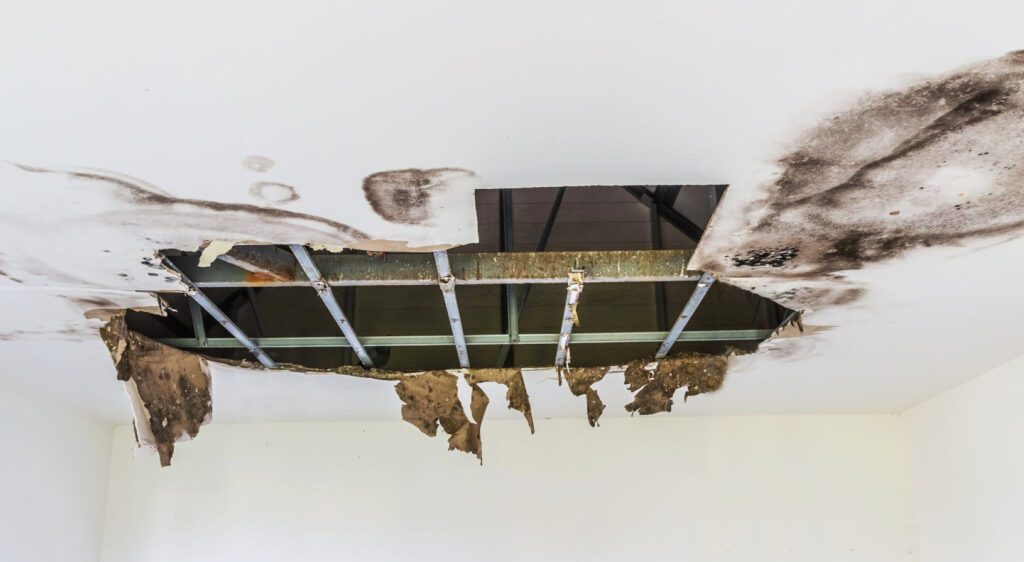Dripping Areas
The first thing you want to do is check if there is still water dripping from the ceiling. In this case, you may want to have a bucket placed underneath the drip. While this will not permanently fix the problem, it will help you monitor the problem and see if you have severe ceiling leaks or not.
Locate The Leak
Your next step is to locate the leak. Yet, it may be wise to hire a seasoned plumber to help you detect the leak.
You can, however, do some of it yourself if you want. For example, you can start by examining any spot where water has gathered on the ceiling (a stain).
Next, check for possible sources of water damage on your walls and ceilings by looking for broken pipes or loose connections. You can also run your hands along with the ceiling, feeling for wetness and water damage.
Water Damage Or Mould Growth
If the water source of the leak is not immediately apparent, you will likely need to get a professional to check your ceilings and walls for mould growth. The ceiling may feel warm or wet to the touch.
Even if no mould has grown yet, you can still experience water damage and mould growth within a few days. To prevent this from appearing, get rid of the moisture and dry out your ceiling as soon as possible.
You can do this by opening all your windows and letting the warm air in your house. You can also use a dehumidifier to raise the humidity level in your home, reducing the risk of mould building up.
If you want to prevent future signs of water damage and mould growth, seal off any holes and cracks on your ceiling before it starts. That could help keep moisture away from other areas where water could leak in. You may want to get a specialist to help you check your walls and ceilings.
Fix The Problem
The next step is to fix the problem. Depending on the extent of the damage, you may want to hire a professional for this job. You can also fix it yourself if it is not too severe.
As for the floor, you will want to remove all debris, including drywall scraps and drywall dust. That is because these materials may mix with water and mix with leftover paint on your walls, which can cause mould growth in the future.
Next, you will need to apply new primer and paint to your ceiling or wallpaper if your drywall or plaster walls are still intact. That is because plaster has a porous surface, which makes it easier for mould to grow. If your ceiling is covered with paint splatter or wallpaper, you will need to remove them first before you can re-paint or re-wallpaper your ceiling.
If water starts dripping on your ceilings again after fixing the problem, there are likely other damaged areas that need repair. You may need to check these areas for water damage and locate the source of the leak.
Call A Professional
If you still notice any signs of water damage or mould growth, you should call a professional to help you fix the problem. You could be facing extensive damage if left untreated.
That is one of the reasons why you should not delay getting repairs done. To find an excellent contractor to help you fix the problem, assess their work and see if it matches your expectations. You can also find companies that deal with mould remediation services by asking friends and family members for recommendations.
Save Money
Ultimately, you don’t want to ignore the problem and hope it will go away.
You may think that you can fix the problem yourself, but it is best to get professional help because you could spend too much money and time on this task. Repairing water damage to your ceilings can be very costly, especially if you lack the proper tools and skills.
If you ignore this problem for a long time, your ceiling may need extensive repairs or replacement. However, that will cost you more money in the long run. It is best to get the problem fixed as soon as possible while preventing future leaks and mould growth.
TO SUM IT UP
Water damage to your ceiling can be very costly if left untreated. That is one of the reasons why you should act fast to remove water and dry out your ceiling. You can use a bucket to help prevent further damage to your ceiling. You may also want to try applying cardboard or any other type of absorbent material under the drips before you attempt to fix them.
If you are not sure if your ceiling is damaged by water, you may want to hire a professional service provider. It will be easier for them to detect the problem within your ceiling. They may also have the tools and skills to repair your ceiling quickly.
Taking this task on yourself will require time, money and skills. However, I hope that the guide above will help you prevent future water damage and mould growth. As always, the floor is yours!


